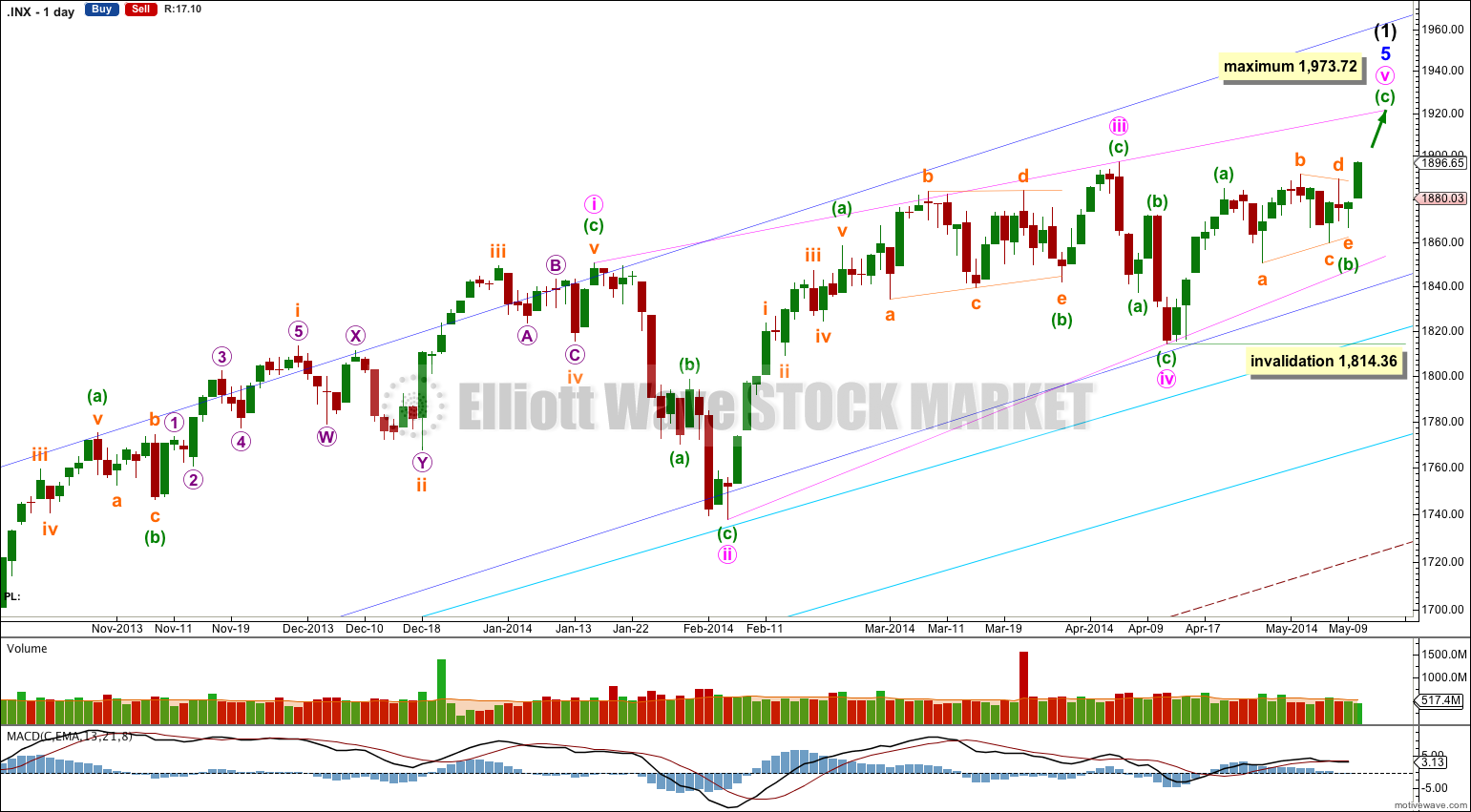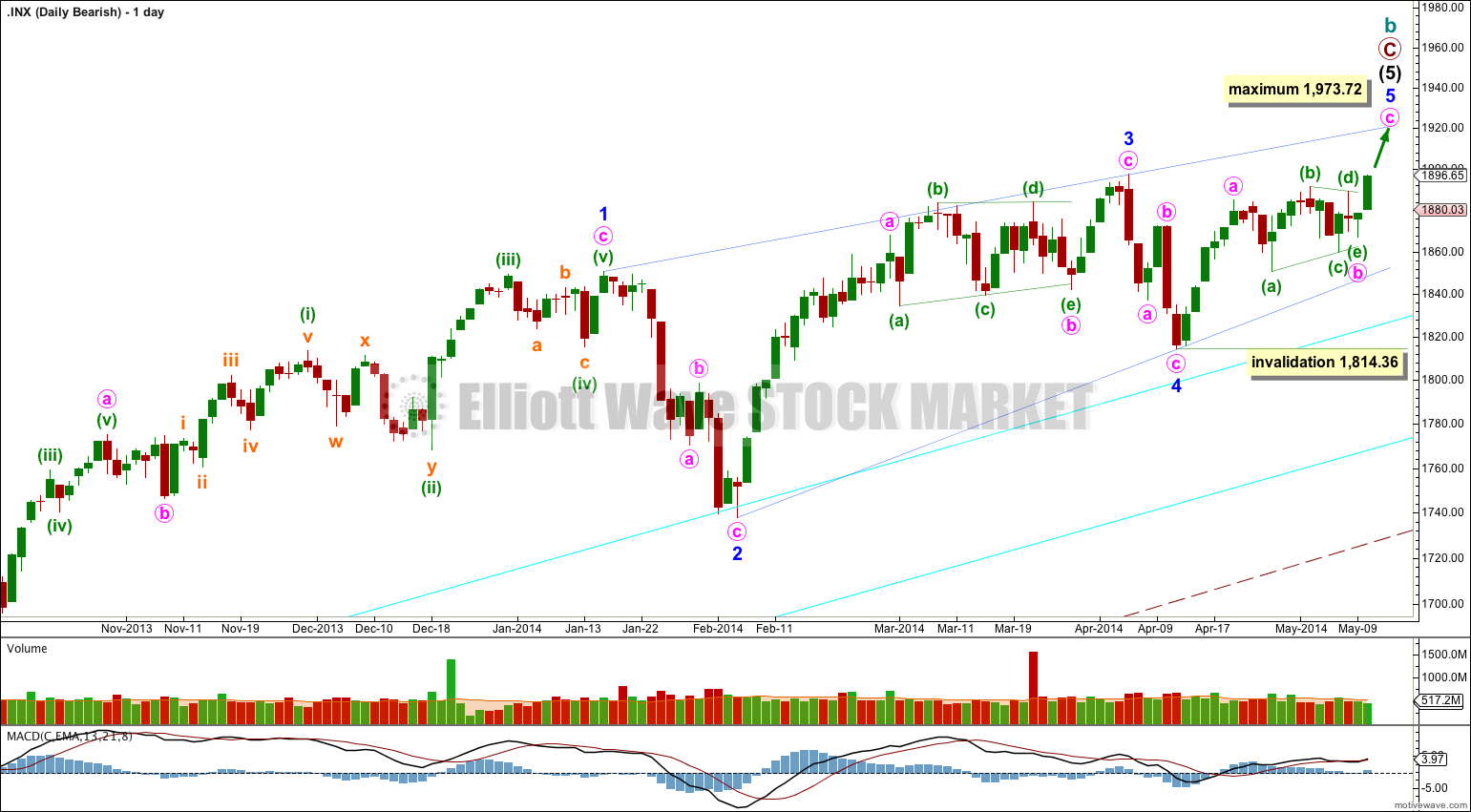Upwards movement was expected. The targets remain the same.
Summary: The first target is 1,911. The second target is 1,938.
This analysis is published about 06:11 p.m. EST. Click on charts to enlarge.
Bullish Wave Count.
The aqua blue trend lines are critical. Draw the first trend line from the low of 1,158.66 on 25th November, 2011 to the next swing low at 1,266.74 on 4th June, 2012. Create a parallel copy and place it on the low at 1,560.33 on 24th June, 2013. While price remains above the lower of these two aqua blue trend lines we must assume the trend remains upwards. This is the main reason for the bullish wave count being my main wave count.
This bullish wave count expects a new bull market began at 666.79 for a cycle wave V. Within cycle wave V primary waves 1 and 2 are complete. Within primary wave 3 intermediate wave (1) is incomplete.
Within intermediate wave (1) the final fifth wave of minor wave 5 is an almost complete ending contracting diagonal. Although minute waves ii and iv within the diagonal are shallower than normal, all the subdivisions fit perfectly. The diagonal is contracting and the final fifth wave may not be longer than equality with the third at 1,973.72.
Within an ending diagonal all the subwaves may only subdivide as single zigzags. The fourth wave should overlap back into first wave price territory. Minute wave v should end when price comes to touch the upper 1-3 trend line of the diagonal. Alternately, it may overshoot this trend line, but that has a lower probability.
Within the zigzag of minute wave v minuette wave (b) may not move beyond the start of minuette wave (a) at 1,814.36.
The triangle is complete and upwards movement from Monday’s session has confirmed this.
The structure at the beginning of minuette wave (c) on the five minute chart is particularly difficult to analyse. If I have made mistakes in this piece of analysis it would favour a higher target. Minuette wave (c) may have begun higher than I have it labeled.
At 1,911 minuette wave (c) would reach 0.618 the length of minuette wave (a). If upwards movement keeps going through this first target, or if when it gets there the structure of minuette wave (c) is incomplete, then the next target is at 1,938 where minuette wave (c) would reach equality in length with minuette wave (a). I expect the second higher target has a higher probability.
Within contracting diagonals the fifth wave often ends when price comes to touch the 1-3 trend line. Sometimes the fifth wave overshoots the 1-3 trend line. If minute wave v ends at the 1-3 pink trend line then the first target may be correct. If minute wave v ends with an overshoot of the 1-3 trend line then the second target may be correct.
The gap at the beginning of Monday’s session I would classify as a breakaway gap and I would not expect it to be filled until intermediate wave (1) is over.
Within subminuette wave iii micro wave 4 may not move back into micro wave 1 price territory below 1,878.57.
Bearish Alternate Wave Count.
This bearish wave count expects that the correction was not over at 666.79, and that may have been just cycle wave a of a huge expanded flat for a super cycle wave II. Cycle wave b upwards is a close to complete zigzag.
Within flat corrections the maximum common length of B waves in relation to A waves is 138%. So far cycle wave b is a 141% correction of cycle wave a. For this reason also this wave count is an alternate.
Within primary wave C the subdivisions are seen here in exactly the same way as the main wave count, both are seen as incomplete five wave impulses with the final fifth wave an almost complete ending contracting diagonal. This bearish wave count would expect a cycle degree trend change to come in a few days.
Alternatively, it is possible that primary wave C is not close to completion. There are several ways to see the many subdivisions within this long movement. The depth of the next downwards correction will tell us what degree the trend change may be: if downwards movement breaches the lower of the two aqua blue trend lines by more than 3% of market value then I would consider a trend change at cycle degree, and if downwards movement breaches the lower edge of the wider maroon – – – channel on the monthly chart then a cycle degree trend change would be confirmed.




